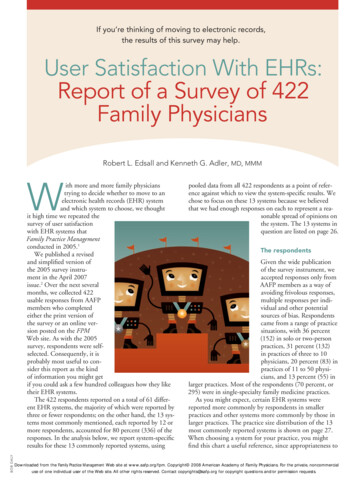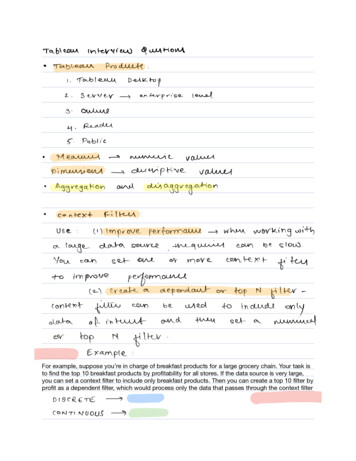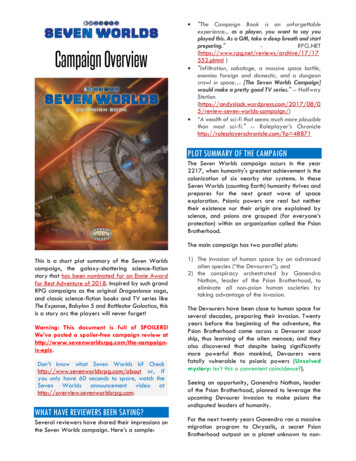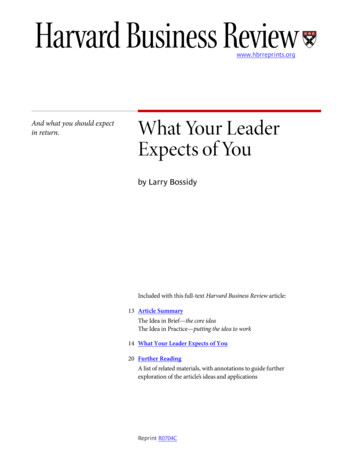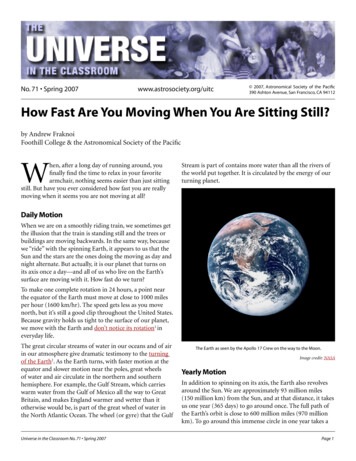
Transcription
No. 71 Spring 2007www.astrosociety.org/uitc 2007, Astronomical Society of the Pacific390 Ashton Avenue, San Francisco, CA 94112How Fast Are You Moving When You Are Sitting Still?by Andrew FraknoiFoothill College & the Astronomical Society of the PacificWhen, after a long day of running around, youfinally find the time to relax in your favoritearmchair, nothing seems easier than just sittingstill. But have you ever considered how fast you are reallymoving when it seems you are not moving at all?Stream is part of contains more water than all the rivers ofthe world put together. It is circulated by the energy of ourturning planet.Daily MotionWhen we are on a smoothly riding train, we sometimes getthe illusion that the train is standing still and the trees orbuildings are moving backwards. In the same way, becausewe “ride” with the spinning Earth, it appears to us that theSun and the stars are the ones doing the moving as day andnight alternate. But actually, it is our planet that turns onits axis once a day—and all of us who live on the Earth’ssurface are moving with it. How fast do we turn?To make one complete rotation in 24 hours, a point nearthe equator of the Earth must move at close to 1000 milesper hour (1600 km/hr). The speed gets less as you movenorth, but it’s still a good clip throughout the United States.Because gravity holds us tight to the surface of our planet,we move with the Earth and don’t notice its rotation1 ineveryday life.The great circular streams of water in our oceans and of airin our atmosphere give dramatic testimony to the turningof the Earth2. As the Earth turns, with faster motion at theequator and slower motion near the poles, great wheelsof water and air circulate in the northern and southernhemisphere. For example, the Gulf Stream, which carrieswarm water from the Gulf of Mexico all the way to GreatBritain, and makes England warmer and wetter than itotherwise would be, is part of the great wheel of water inthe North Atlantic Ocean. The wheel (or gyre) that the GulfUniverse in the Classroom No. 71 Spring 2007The Earth as seen by the Apollo 17 Crew on the way to the Moon.Image credit: NASAYearly MotionIn addition to spinning on its axis, the Earth also revolvesaround the Sun. We are approximately 93 million miles(150 million km) from the Sun, and at that distance, it takesus one year (365 days) to go around once. The full path ofthe Earth’s orbit is close to 600 million miles (970 millionkm). To go around this immense circle in one year takes aPage 1
speed of 66,000 miles per hour (107 million km/hr)3. Atthis speed, you could get from San Francisco to WashingtonDC in 3 minutes. As they say on TV, please don’t try goingthis fast without serious adult supervision.The Sun, seen in ultraviolet light with instruments aboard the SOHO satellite.Image credit: SOHOThe Sun’s MotionOur Sun is just one star among several hundred billionothers that together make up the Milky Way Galaxy. Thisis our immense “island of stars” and within it, each staris itself moving. Any planet orbiting a star will share itsmotion through the Galaxy with it. Stars, as we shall see,can be moving in a random way, just “milling about” intheir neighborhoods, and also in organized ways, movingaround the center of the Galaxy.If we want to describe the motion of a star like our Sunamong all the other stars, we run up against a problem. Weusually define motion by comparing the moving objectto something at rest. A car moves at 60 miles per hourrelative to a reference post attached to the Earth, such as thehighway sign, for example. But if all the stars in the Galaxyare moving, what could be the “reference post” to which wecan compare its motion?Astronomers define a local standard of rest in our sectionof the Galaxy by the average motion of all the stars in ourneighborhood4. (Note that in using everyday words, such as“local” and “neighborhood”, we do a disservice to the mindboggling distances involved. Even the nearest star is over25 thousand billion miles (40 thousand billion km) away.Universe in the Classroom No. 71 Spring 2007It’s only that the Galaxy is so immense, that compared toits total size, the stars we use to define our Sun’s motion doseem to be in the “neighborhood.”)Relative to the local standard of rest, our Sun and theEarth are moving at about 43,000 miles per hour (70,000km/hr) roughly in the direction of the bright star Vega inthe constellation of Lyra. This speed is not unusual for thestars around us and is our “milling around” speed in oursuburban part of the Galaxy.The Sun travels with billions of other stars through the Milky Way Galaxy, whichis thought to look much like the Andromeda Galaxy, pictured above.Image credit: NASA Marshall Space Flight Center (NASA-MSFC)Orbiting the GalaxyIn addition to the individual motions of the stars within it,the entire Galaxy is in spinning motion like an enormouspinwheel. Although the details of the Galaxy’s spin arecomplicated (stars at different distances move at differentspeeds), we can focus on the speed of the Sun around thecenter of the Milky Way Galaxy5.It takes our Sun approximately 225 million years to makethe trip around our Galaxy. This is sometimes called our“galactic year”. Since the Sun and the Earth first formed,about 20 galactic years have passed; we have been aroundthe Galaxy 20 times. On the other hand, in all of recordedhuman history, we have barely moved in our long patharound the Milky Way.How fast do we have to move to make it around the MilkyWay in one galactic year? It’s a huge circle, and the speedwith which the Sun has to move is an astounding 483,000miles per hour (792,000 km/hr)! The Earth, anchored tothe Sun by gravity, follows along at the same fantastic speed.(By the way, as fast as this speed is, it is still a long way fromthe speed limit of the universe—the speed of light. Lighttravels at the unimaginably fast pace of 670 million milesper hour or 1.09 billion km/hr.)Page 2
An artist’s illustration of the Milky Way GalaxyImage credit: NASA / CXC / M. WeissMoving through the UniverseAs we discussed the different speeds of our planet so far,we always needed to ask, “Compared to what are youmeasuring this motion?” In your armchair, your motioncompared to the walls of your room is zero. Your motioncompared to the Moon or the Sun, on the other hand, isquite large. When we talk about your speed going aroundthe Galaxy, we measure it relative to the center of the MilkyWay.Now we want to finish up by looking at the motion ofthe entire Milky Way Galaxy through space. What can wecompare its motion to—what is the right frame of reference?For a long time, astronomers were not sure how to answerthis question. We could measure the motion of the MilkyWay relative to a neighbor galaxy, but this galaxy is alsomoving. The universe is filled with great islands of stars(just like the Milky Way) and each of them is moving in itsown way. No galaxy is sitting still! But then, a surprisingdiscovery in the 1960s showed us a new way to think of ourgalaxy’s motion.The Flash of the Big BangTo understand this new development, we have to think alittle bit about the Big Bang, the enormous explosion thatwas the beginning of space, time, and the whole universe.Right after the Big Bang, the universe was full of energy andvery, very hot. In fact, for the first few minutes, the entireuniverse was hotter than the center of our Sun. It was anunimaginable maelstrom of energy and subatomic particles,slowly cooling and sorting itself out into the universe weknow today.The Hubble Deep Field image shows some ofthe most distant Galaxies in the Universe.Image credit: Robert Williams and the Hubble Deep Field Team (STScI) and NASAUniverse in the Classroom No. 71 Spring 2007At that early time, the energy in the universe was in theform of gamma rays, waves of energy like the visiblePage 3
light we see, but composed of much shorter waves withhigher energy. Today on Earth, it takes a nuclear bombto produce significant amounts of gamma rays. But then,the whole universe was filled with them. You can think ofthese gamma-rays as the “flash” of the Big Bang—just likefireworks or a bomb can produce a flash of light, the BigBang resulted in a flash of gamma rays. But these gammarays were everywhere in the universe. They filled all ofspace, and as the universe grew (expanded), the gamma raysexpanded with it.When people first think about the expansion of theuniverse, they naturally think of other expansions they haveexperience with: how the American colonies eventuallyexpanded to become the 48 states of the U.S. or how anexploding bomb might throw shrapnel in every direction.In these situations, the space into which the colonies orthe shrapnel is expanding already exists. But the expansionof the universe is not like any other expansion. When theuniverse expands, it is space itself that is stretching. Thegalaxies in the universe are moving apart because spacestretches and creates more distance between them.What does this mind-stretching idea of stretching spacemean for our gamma rays? The gamma rays are waves ofenergy moving through space. As space stretches, the wavesthat are in space must stretch too. Stretched gamma raysare called x-rays. So as the universe expanded, the waves ofenergy filling space stretched out to become less energetic(cooler) x-rays. As the universe continued to expand, thesame waves became ultra-violet light. Later they becamevisible light, but there were no eyes in the hot compresseduniverse to see them yet. (When we take the lid of a hotpressure cooker, the steam will expand into the room andcool down. In the same way, we can think of the waves ofenergy in the expanding universe as cooling down—gettingless energetic.)telescopes and rockets in orbit to confirm that the radiowaves the two scientists had discovered were really comingfrom all over space, Penzias and Wilson received the NobelPrize in physics for having found the most direct evidencefor the Big Bang.WMAP image of the Cosmic Microwave Background radiationImage credit: NASA/WMAP Science TeamMoving through the CBRWhat, you might be asking yourself, does all this have to dowith how fast we are moving? Well, astronomers can nowmeasure how fast the Earth is moving compared to thisradiation filling all of space. (Technically, our motion causesone kind of Doppler Shift7 in the radiation we observein the direction that we are moving and another in thedirection opposite.)Put another way, the CBR provides a “frame of reference”for the universe at large, relative to which we can measureour motion. From the motion we measure compared to theToday, some 12 to 15 billion years after the Big Bang, therehas been a lot of stretching. Space has expanded quite a bit.The flash of the Big Bang has stretched until it is now muchlonger, lower energy waves—microwaves and other radiowaves. But the waves have stretched with the space theyoccupy, and so they still fill the universe, just the way theydid at the time of creation.Astronomers call the collection of all these stretched wavesthe cosmic background radiation6 or CBR. Physicists backin the late 1940’s predicted that there should be such abackground, but since no one had the equipment to findit, the prediction was forgotten. Then, in the mid 1960s,two scientists working for Bell Laboratories, Arno Penziasand Robert Wilson, accidentally discovered the CBR whilehelping to get communications satellite technology goingfor the phone company. After astronomers used otherUniverse in the Classroom No. 71 Spring 2007There is thought to be a large concentration of mass in the in the direction ofLeo and Virgo, since the galaxies near the Milky Way seem to be streaming inthat direction. A portion of this section of the sky is shown in the image above.Image credit: ESOPage 4
CBR, we need to subtract out the motion of the Eartharound the Sun and the Sun around the center of the MilkyWay. The motion that’s left must be the particular motionof our Galaxy through the universe!And how fast is the Milky Way Galaxy moving? Thespeed turns out to be an astounding 1.3 million miles perhour (2.1 million km/hr)! We are moving roughly in thedirection on the sky that is defined by the constellations ofLeo and Virgo. Although the reasons for this motion are notfully understood, astronomers believe that there is a hugeconcentration of matter in this direction. Some people callit The Great Attractor, although we now know that the pullis probably not due to one group of galaxies but many. Stillthe extra gravity in this direction pulls the Milky Way (andmany neighbor galaxies) in that direction.No Rest for the WearyAbout the AuthorAndrew Fraknoi is the Chair of the Astronomy Departmentat Foothill College and Educational Consultant for theAstronomical Society of the Pacific. Before joining thefaculty at Foothill in 1992, he served as the Society’sExecutive Director for 14 years and was the editor of itspopular-level astronomy magazine, Mercury, as well as thefounder of this teacher’s newsletter, the Universe in theClassroom.Fraknoi is author or coauthor of 14 books on astronomyand astronomy education, editor of the Universe at YourFingertips, a frequent guest on national radio programs, amember of the Board of Trustees at the SETI Institute, anda Fellow of the Committee for the Scientific Investigation ofClaims of the Paranormal (CSICOP). Together with SidneyWolff, he also edits Astronomy Education Review, an online journal for astronomy educators.So the next time someone in your family or group of friendscalls you lazy for just sitting there, you can politely remarkthat, although it may look as if you are just sitting, you areactually moving at great speed around the Earth, aroundthe Sun, around the Milky Way, and through the universe.Surely, a lot of energy is required for all that motion. I’llconfess this line has never gotten me out of having to dohousehold chores for long, but perhaps you’ll have betterluck with it. And your students, who often have troublesitting still, will surely appreciate learning that, cosmicallyspeaking, they are in constant motion.Little Girl in Blue Armchair by Mary Cassatt, National Gallery of Art,Collection of Mr. & Mrs. Paul MellonUniverse in the Classroom No. 71 Spring 2007Page 5
Classroom Activity #1: Your Galactic AddressIn this activity, students explore the different realms of the cosmos and our place in the larger universe by addressing aletter to a friend in a distant galaxy. Rather than just including house number, street, city, state and country, they alsoinclude their place in the solar system and the galaxy.The entire write-up for this activity is available here8. This activity is printed here with permission from PlanetariumActivities for Student Success (PASS; http://lhs.berkeley.edu/pass), produced by the Lawrence Hall of Science, University ofCalifornia, Berkeley. Copyright 1993 by the Regents of the University of California. A number of astronomy activities areavailable for free download on the PASS website.Classroom Activity #2: Cosmic CalendarCosmology—the study of our universe, how it began, and how it has evolved—can seem incomprehensible to studentsbecause of the vast eons of time between today and the beginning of the universe. This activity will provide a “bridge”across time that will make the numbers more meaningful.In “Cosmic Calendar” 9, students scale the evolution of the universe to a one year calendar, with the Big Bang occuring onthe first moment of January 1st. Students estimate where on this one year time line significant events (like the formation ofthe solar system, the appearance of dinosaurs and the emergence of humanity) should be placed. More advanced studentscan research the dates of significant events and calculate when in the model timeline these events occurred.This activity appears in the Universe at Your Fingertips and was written by Therese Puyau Blanchard and the staff ofProject ASTRO. Copyright 1995, Astronomical Society of the Pacific, 390 Ashton Ave., San Francisco, CA 94112.Universe in the Classroom No. 71 Spring 2007Page 6
Resources1. Ask An Astronomer: Are we able to feel the Earth ?number 6652. Coriolis Effect: how the spinning of the Earth affects the tides and windshttp://books.nap.edu/html/oneuniverse/motion 32-33.html3. Ask An Astronomer: At what speed does the Earth move around the number 3564. The Solar ate/AssetDetail/assetid/21173/page/25. The Milky Way Galaxyhttp://www.windows.ucar.edu/tour/link /the universe/Milkyway.html&edu mid6. Cosmic Microwave Backgroundhttp://map.gsfc.nasa.gov/m uni/uni 101bbtest3.html7. Redshift and the Expanding e/tools/doppler.html8. Classroom Activity: Your Galactic Address from PASS at the Lawrence Hall of 9-GalacticAddress.pdf9. Classroom Activity: Cosmic o/act2/cosmic.htmlAdditional ResourcesAsk An AstronomerOn this page, a Cornell astronomer answers the following question: Considering the motion of the Earth, the solar system,and the galaxy, how fast am I moving while lying in bed hp?number 507“Where Are We Going? Notes on the Absolute Motion of the Solar System Through Space.”by Timothy Ferris, Sky & Telescope, May, 1987 (available in most large libraries)The NASA Universe ForumFrom the Harvard Smithsonian Center for Astrophysics, this is a national center for teaching and learning about dex.htmOne Universe: At Home in the CosmosThis book details the origins and fate of the Unverse, with chapters on motion and energy. Written at a good popular levelby well-know astronomers and science educators Neil De Grasse Tyson, Charles Lui, and Rober Irion, the entire text isavailable for free .htmlAn Ancient Universe: How Astronomers Know the Vast Scale of Cosmic TimeThis special edition of The Universe in the Classroom gives some of the background on how scientists have been able tomeasure cosmic ages as well as some references to classroom activities and resources for further exploration of some theastronomical blications/tnl/56/index.htmlUniverse in the Classroom No. 71 Spring 2007Page 7
(By the way, as fast as this speed is, it is still a long way from the speed limit of the universe—the speed of light. Light travels at the unimaginably fast pace of 670 million miles per hour or 1.09 billion km/hr.) Image credit: SOHO The Sun, seen in ultr


